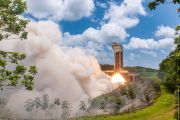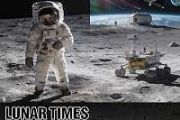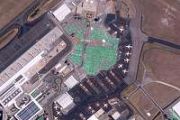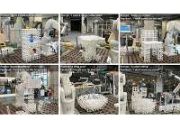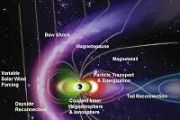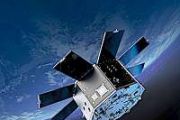
Copernical Team
SSC confirms L3Harris's design for Next-Gen Missile Detection Sensors
US and Australia signs Space Technology Safeguards Agreement
 In a significant development for the global space industry, Australia and the United States have formalized a Technology Safeguards Agreement (TSA), marking a pivotal moment for both nations' space sectors. This treaty-level agreement, signed in October last year and recently detailed by the Australian Government, sets the stage for enhanced cooperation in space technology and exploration, parti
In a significant development for the global space industry, Australia and the United States have formalized a Technology Safeguards Agreement (TSA), marking a pivotal moment for both nations' space sectors. This treaty-level agreement, signed in October last year and recently detailed by the Australian Government, sets the stage for enhanced cooperation in space technology and exploration, parti SKorea enhances military operations with Iridium connectivity
 In a significant move towards modernizing its military communication infrastructure, the Republic of Korea (ROK) Ministry of Defense has officially integrated Iridium Communications Inc.'s (NASDAQ: IRDM) satellite connectivity into its operational framework. This strategic adoption of Iridium's comprehensive suite of communication solutions marks a pivotal advancement in the ROK Army's capabilit
In a significant move towards modernizing its military communication infrastructure, the Republic of Korea (ROK) Ministry of Defense has officially integrated Iridium Communications Inc.'s (NASDAQ: IRDM) satellite connectivity into its operational framework. This strategic adoption of Iridium's comprehensive suite of communication solutions marks a pivotal advancement in the ROK Army's capabilit BAE Systems to pioneer ground system for Space Force's missile defense upgrade
 In a pivotal development for U.S. national security, BAE Systems (LON: BA) has been chosen by the Space Systems Command (SSC) Space Enterprise Consortium (SpEC) to spearhead the development of a prototype ground system for the U.S. Space Force. This system, part of the Future Operationally Resilient Ground Evolution Command and Control (FORGE C2) project, aims to overhaul the current ground arch
In a pivotal development for U.S. national security, BAE Systems (LON: BA) has been chosen by the Space Systems Command (SSC) Space Enterprise Consortium (SpEC) to spearhead the development of a prototype ground system for the U.S. Space Force. This system, part of the Future Operationally Resilient Ground Evolution Command and Control (FORGE C2) project, aims to overhaul the current ground arch China opens first simulated environment for space research
 In an impressive stride toward advancing its space research capabilities, China has unveiled its first Space Environment Simulation and Research Infrastructure (SESRI) facility, marking a significant milestone in the nation's aerospace endeavors.
This cutting-edge facility, developed through a collaboration between the Harbin Institute of Technology (HIT) and the China Aerospace Science an
In an impressive stride toward advancing its space research capabilities, China has unveiled its first Space Environment Simulation and Research Infrastructure (SESRI) facility, marking a significant milestone in the nation's aerospace endeavors.
This cutting-edge facility, developed through a collaboration between the Harbin Institute of Technology (HIT) and the China Aerospace Science an Study reveals potential for life's building blocks from Mars' ancient atmosphere
 In a groundbreaking study that could redefine our understanding of life's potential on ancient Mars, scientists from Tohoku University have unveiled research indicating that organic materials discovered on the Red Planet may have originated from atmospheric formaldehyde. This discovery, published in Scientific Reports, suggests a plausible pathway for the formation of biomolecules-organic compou
In a groundbreaking study that could redefine our understanding of life's potential on ancient Mars, scientists from Tohoku University have unveiled research indicating that organic materials discovered on the Red Planet may have originated from atmospheric formaldehyde. This discovery, published in Scientific Reports, suggests a plausible pathway for the formation of biomolecules-organic compou NASA and SpaceX complete docking system tests for Lunar Starship Lander
 In a pivotal advancement for lunar exploration, NASA and SpaceX have recently concluded qualification testing for a docking system integral to the Artemis campaign's success. This campaign aims to lay the groundwork for sustained scientific exploration on the Moon, requiring seamless transfers between spacecraft for lunar landings. The testing phase marks a significant step forward in ensuring t
In a pivotal advancement for lunar exploration, NASA and SpaceX have recently concluded qualification testing for a docking system integral to the Artemis campaign's success. This campaign aims to lay the groundwork for sustained scientific exploration on the Moon, requiring seamless transfers between spacecraft for lunar landings. The testing phase marks a significant step forward in ensuring t MAPHEUS 14 high-altitude research rocket takes flight
 On 27 February 2024 at 8:27 CET the MAPHEUS 14 high-altitude research rocket, operated by the German Aerospace Center, successfully launched from the Esrange Space Center near Kiruna, Sweden. The high-altitude rocket reached an altitude of 265 kilometres and provided approximately six and a half minutes of microgravity for its scientific payload - a total of 14 experiments which were all safely
On 27 February 2024 at 8:27 CET the MAPHEUS 14 high-altitude research rocket, operated by the German Aerospace Center, successfully launched from the Esrange Space Center near Kiruna, Sweden. The high-altitude rocket reached an altitude of 265 kilometres and provided approximately six and a half minutes of microgravity for its scientific payload - a total of 14 experiments which were all safely As mission ends, US lunar lander could still 'wake' back up
 The US spacecraft that touched down on the Moon last week and is currently running on solar power will soon be "put to sleep" once lunar night kicks in, mission officials said Wednesday.
But while the mission that saw the first ever Moon landing by a private company is coming to an end, Intuitive Machines CEO Steve Altemus told reporters that there are hopes to "wake it up" in about three we
The US spacecraft that touched down on the Moon last week and is currently running on solar power will soon be "put to sleep" once lunar night kicks in, mission officials said Wednesday.
But while the mission that saw the first ever Moon landing by a private company is coming to an end, Intuitive Machines CEO Steve Altemus told reporters that there are hopes to "wake it up" in about three we One week left to apply for the ESA Young Graduate Trainee Programme

The ESA Young Graduate Trainee call for applications closes on 7 March 2024. Don’t hesitate to apply and kick-start your career in space today! Positions are available in engineering, science, IT and business services.













